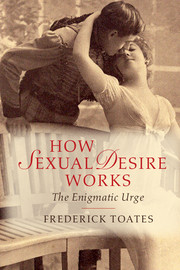Book contents
- Frontmatter
- Dedication
- Contents
- List of figures
- Preface
- One What is enigmatic about sexual desire?
- Two Explaining desire: multiple perspectives
- Three Sexual desire in a broad context
- Four An incentive-based model
- Five Sex and levels of organization
- Six Sexual attraction
- Seven Shades of desire from simple to complex
- Eight Details of the brain and desire
- Nine Arousal
- Ten The consequences of sexual behaviour and associated expectations
- Eleven Sexual familiarity and novelty
- Twelve Inhibition, conflict and temptation
- Thirteen How did sexual desire get here?
- Fourteen Setting the trajectory: link to adult sexuality
- Fifteen Sexual desire in interaction
- Sixteen Representations of sex
- Seventeen Sexual addiction
- Eighteen Variations in desire: general principles
- Nineteen Some forms of desire at the fringes
- Twenty The toxic fusion: violence and sexual desire
- Twenty one Sexually associated (serial) murder
- Twenty two Concluding remarks
- Notes
- References
- Index
Four - An incentive-based model
Published online by Cambridge University Press: 05 October 2014
- Frontmatter
- Dedication
- Contents
- List of figures
- Preface
- One What is enigmatic about sexual desire?
- Two Explaining desire: multiple perspectives
- Three Sexual desire in a broad context
- Four An incentive-based model
- Five Sex and levels of organization
- Six Sexual attraction
- Seven Shades of desire from simple to complex
- Eight Details of the brain and desire
- Nine Arousal
- Ten The consequences of sexual behaviour and associated expectations
- Eleven Sexual familiarity and novelty
- Twelve Inhibition, conflict and temptation
- Thirteen How did sexual desire get here?
- Fourteen Setting the trajectory: link to adult sexuality
- Fifteen Sexual desire in interaction
- Sixteen Representations of sex
- Seventeen Sexual addiction
- Eighteen Variations in desire: general principles
- Nineteen Some forms of desire at the fringes
- Twenty The toxic fusion: violence and sexual desire
- Twenty one Sexually associated (serial) murder
- Twenty two Concluding remarks
- Notes
- References
- Index
Summary
Some people – probably fewer than are claimed by science and folklore – eschew or are denied sexual pleasure for their entire lives, without apparent ill effects. It is all the more remarkable, therefore, that millions of people throughout the ages have eagerly risked life, limb, property, freedom, tranquillity, family, reputation, happiness, have even accepted sure and eternal damnation, all for the attainment, not of offspring, but of sexual pleasure.
(Tuzin, 1995, p. 259)Is sexual desire part of a regulator?
Sexual desire and behaviour appear superficially to exhibit some features of regulation. However, as Chapter 3 indicated, there is little evidence to support any of the actual regulatory processes that have been postulated over the centuries and considerable evidence against them.
With little controversy, deprivation of sexual opportunity can be felt by some as aversive, while sexual outlet is felt as pleasurable and restorative. This much is in common with feeding and drinking, systems unambiguously concerned with regulation. Or, to take another analogy, there is at least something in common with a full bladder and the urge to urination. However, while acknowledging some level of similarity, one needs to look closer and ask – where lies the source of distress that comes from not being able to express sexual desire? Considering the similarities and differences with feeding and drinking can give useful pointers to the design of sexual desire (Singer and Toates, 1987).
- Type
- Chapter
- Information
- How Sexual Desire WorksThe Enigmatic Urge, pp. 95 - 111Publisher: Cambridge University PressPrint publication year: 2014

